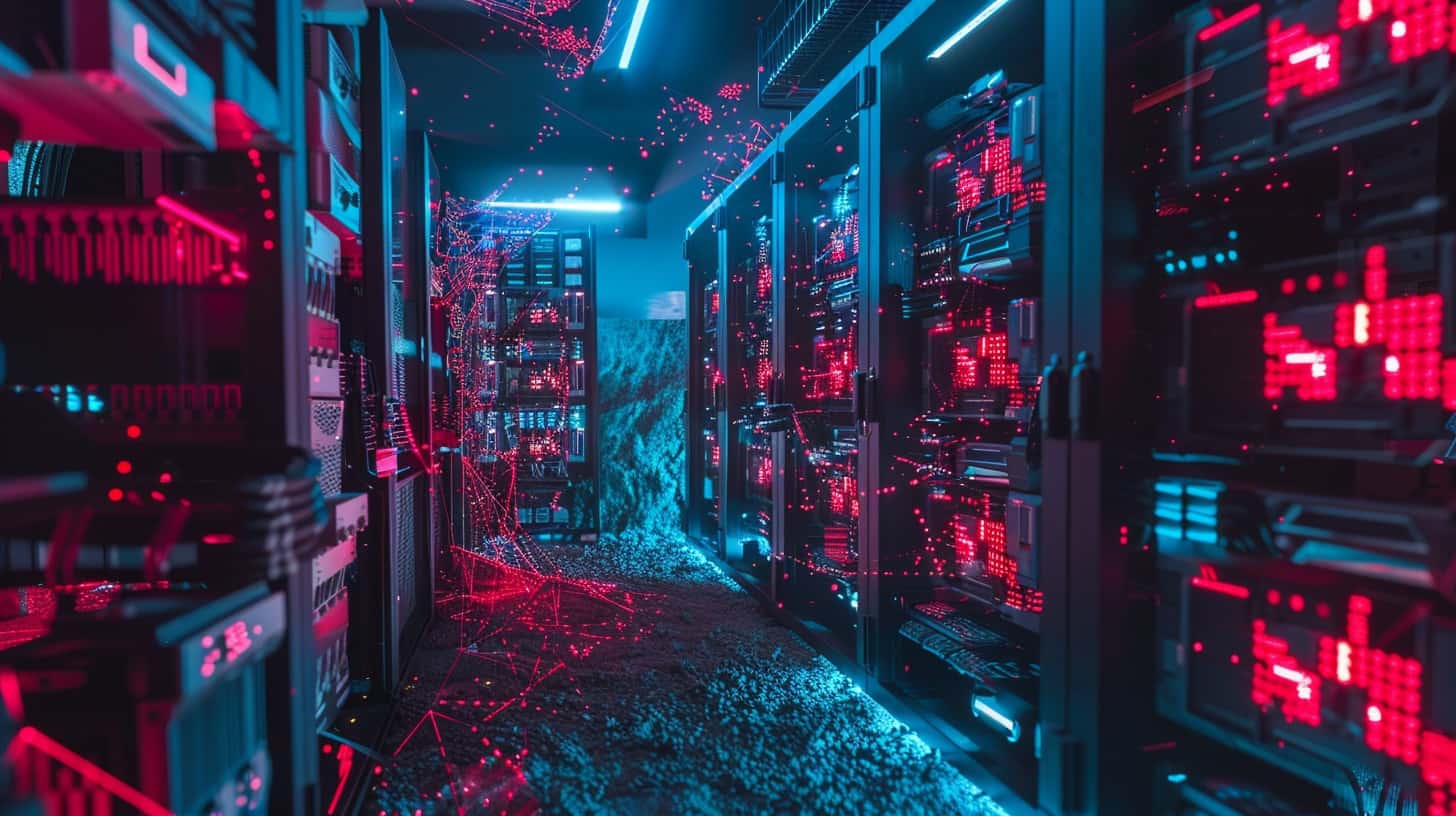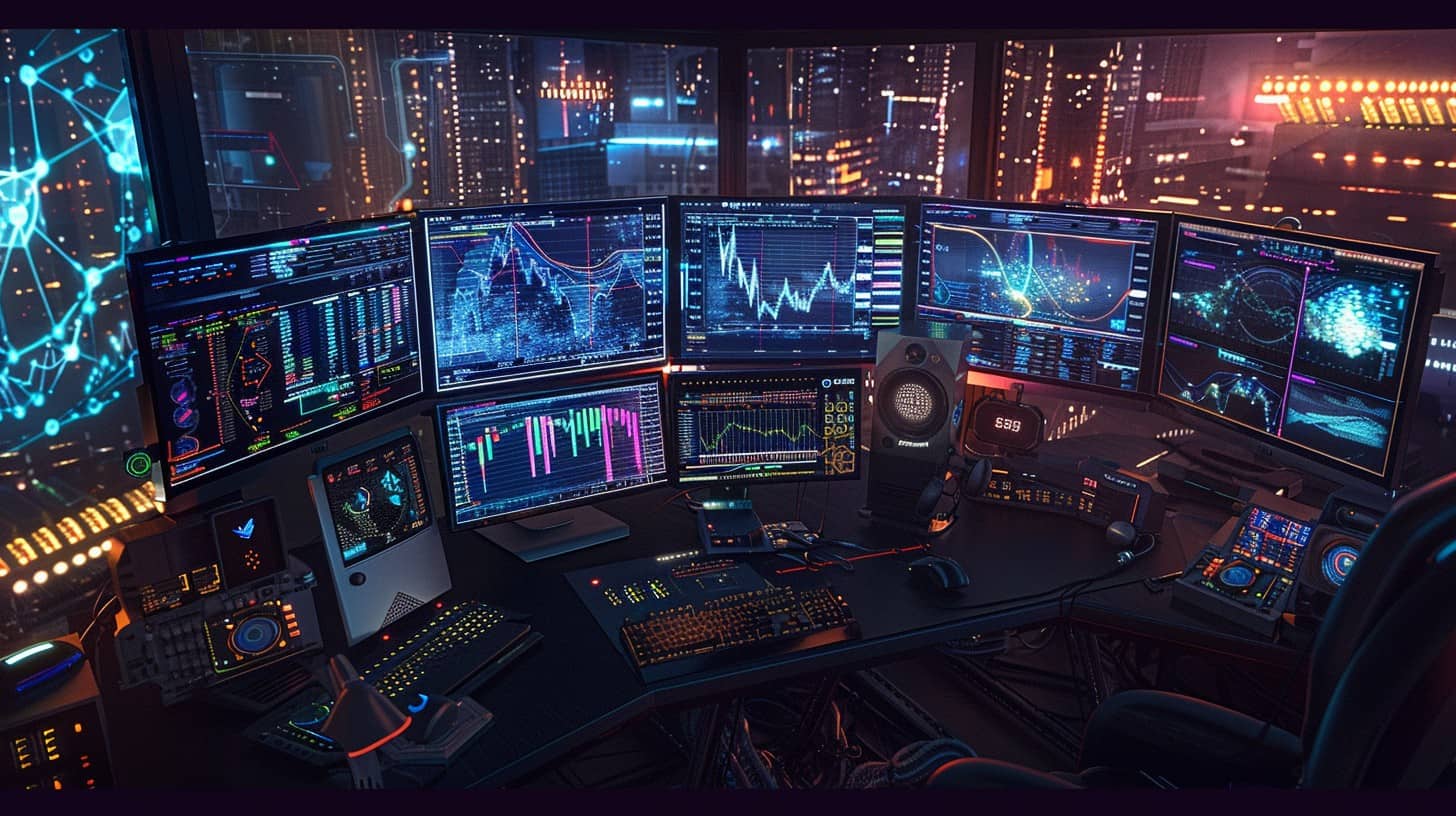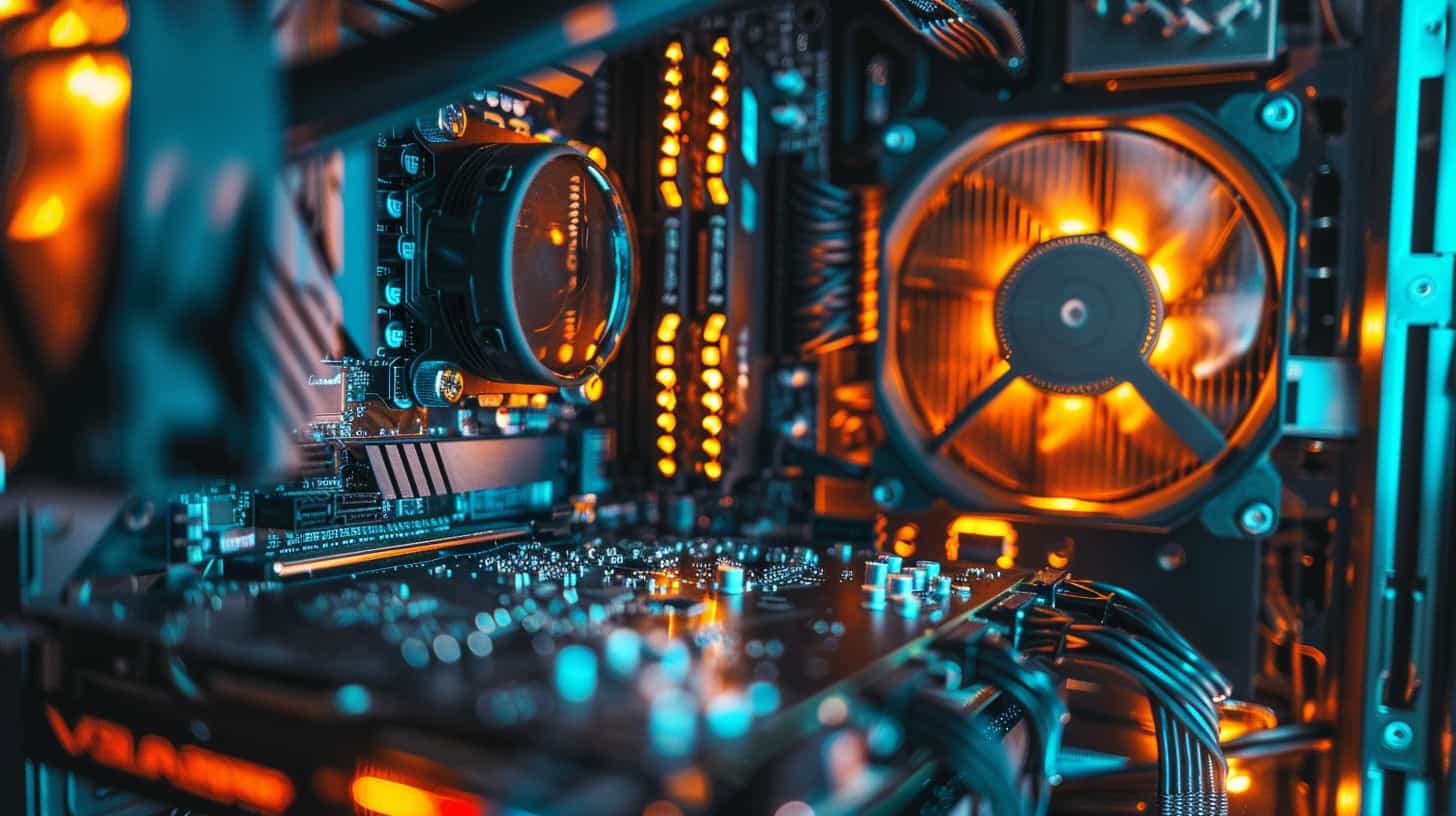Thinking about mining crypto but don’t have the fancy setup? Here’s a nugget for you: virtual PCs might just be your ticket in. This article peels back the layers on mining with a digital clone of your computer, highlighting both the slick moves and stumbling blocks.
Ready to get clued in? Keep reading.
Key Takeaways
Virtual PCs can mine cryptocurrencies like Monero and Quantum Resistant Ledger but don’t have the same power as dedicated mining rigs. They are good for beginners to learn and perform small-scale mining experiments.
Mining on virtual PCs has both benefits and challenges. The pros include flexibility, low risk for beginners, easy scaling, and less space required. However, cons involve limitations with GPU power, higher electricity costs, reduced computational efficiency, and potential technical difficulties.
Traditional mining rigs outperform virtual PC setups in speed, efficiency, profitability, and direct hardware access. Virtual rigs offer higher flexibility and lower beginner risks, but may not be ideal for serious miners aiming for high profits.
Setting up a virtual mining rig involves choosing the right software like Microsoft Hyper – V or Parallels Desktop; setting up a strong host machine; installing guest operating systems; joining a mining pool; constantly monitoring optimization settings; being aware of electricity costs.
Future trends in virtual PC mining point towards growing popularity due to advancing technology like cloud computing. Innovations could make setup easier and more powerful without needing physical hardware setups, but the challenge remains in balancing cost against profit in an evolving crypto landscape.
Table of Contents
Understanding Crypto Mining

Crypto mining is like a treasure hunt. You solve complex math problems, and if you’re the first to crack the code, bingo! You earn cryptocurrencies like Bitcoin or Ethereum as your prize.
Think of it as a race where your computer competes against others from around the globe. The faster and more powerful your “mining rig” – that’s what we call the computer doing all this hard work – the better are your chances to win this digital gold rush.
Many businesses online are now jumping on the crypto bandwagon, offering crypto promotions if you pay with cryptocurrencies. They want more digital coins flowing through their business; it’s like having a magnet for geeks who love spending their mined treasures.
From my own adventures in mining, let me tell you: seeing those rewards stack up feels like hitting jackpot after jackpot in Las Vegas, only without the bright lights and loud noises.
Mining cryptocurrency isn’t just about making money; it’s about powering up the future of finance.
Virtual PCs: Definitions and Mining Capabilities

Virtual PCs act like your normal computer, but they live inside software. They can mine crypto just like a real machine does with the right setup.
Exploring Virtual PCs
Virtual PCs act like your regular computer but live inside software. They use programs like Oracle VM VirtualBox and VMware Workstation Pro to run. Think of them as computers within computers.
This setup lets you try out different operating systems, from Windows 10 Pro to macOS, without messing up your real computer.
I set up a virtual machine on my laptop to see how it works. It was easier than I thought! First, I picked Oracle VM VirtualBox because it’s free and user-friendly. Then, I created a new virtual machine for mining Monero (XMR).
I had to adjust the settings to give it enough power from my laptop’s CPU and GPU. Even though these virtual environments can’t access all of the hardware’s juice directly—especially the GPUs—they’re great for learning and small-scale mining experiments.
Virtualization Technologies Overview
Virtualization technologies split one physical machine into many virtual ones. They use software like VMware and VirtualBox to create these separate environments. Think of it as having a bunch of mini-computers inside your one big computer.
Each can run its own show, mining cryptocurrencies or doing other tasks, without stepping on each other’s toes.
During my time experimenting with both full virtualization and paravirtualization, I noticed something cool. These methods let your virtual PCs act almost like real ones, but faster in some cases! Full virtualization fools the operating system into thinking it’s running on its own hardware.
Paravirtualization goes a step further by acknowledging it’s in a shared space, which helps things run smoothly.
Now that we’ve laid out how these technologies work, let’s dig into what happens when you try mining crypto using them.
Analyzing Crypto Mining on Virtual PCs

Mining crypto on virtual PCs is like putting your digital pickaxe to work in a virtual land. It’s a mix of old mining grit and new tech smarts, where your computer does the heavy lifting to dig up digital coins.
Feasibility of Mining Crypto on Virtual PCs
Mining crypto on virtual PCs can work, but it’s not a walk in the park. Virtual machines share your computer’s resources. This setup means they usually don’t pack the same punch as a dedicated mining rig.
Think of it like trying to run a marathon with someone piggybacking on you – possible, but you won’t set any records. For coins like Monero (XMR) or Quantum Resistant Ledger (QRL), which are kinder to less powerful setups, virtual PC mining shines brighter.
Pros include slashing physical space and letting beginners test waters without sinking their ship first. Yet, challenges linger like lower profit margins and the struggle to use all of a graphic card’s might due to the virtual layer adding extra hurdles.
Tools such as MSI Afterburner for tweaking settings or joining forces with mining pools become crucial allies in this quest.
Mining in the cloud: where dreams of digital gold rush meet the reality of virtual shovels.
Virtual vs. Traditional Mining Performance Comparison
After exploring the feasibility of mining cryptocurrency on virtual PCs, let’s shift gears to see how they stack up against traditional mining setups. Here’s the lowdown on virtual versus traditional mining performance.
| Aspect | Virtual PC Mining | Traditional Mining |
|---|---|---|
| Speed | Slower, due to limited access to physical hardware | Fast, as it directly utilizes the full power of the hardware |
| Efficiency | Less efficient, higher overhead costs due to virtualization layers | Highly efficient, optimized hardware for mining |
| Profitability | Lower, because of reduced mining speed and efficiency | Higher, thanks to superior performance and optimization |
| Hardware Access | Limited, especially GPUs crucial for mining | Direct and complete, leveraging specialized ASICs and graphics cards |
| Flexibility | High, easy to scale and experiment with | Lower, physical modifications required for scaling |
| Space Requirements | Minimal, multiple virtual machines on one physical server | Significant, larger setups need more physical space |
| Risk for Beginners | Low, a safe sandbox for learning and testing | Higher, initial costs and complexity can be barriers |
This table lays it out straight. Traditional mining rigs are speed demons compared to their virtual counterparts. They munch through calculations faster than a kid through a candy store. But don’t write off virtual mining rigs just yet. They have their charm, like being the Swiss Army knife of the crypto mining world—flexible, adaptable, and perfect for those dipping their toes in the mining pool.
Yet, when you’re in it to win it, traditional mining rigs stand tall. They’re like the heavyweights of the mining world, built for one purpose and doing it well. Virtual rigs, bless their hearts, struggle to keep up due to those pesky virtualization layers eating into their lunch.
And let’s talk turkey about profits. Traditional rigs might cost more upfront but think of them as the goose that lays golden eggs. Virtual rigs, on the other hand, are like having a savings account with a low-interest rate. Sure, you’re earning something, but it’s not going to make you rich overnight. For those who prefer a safer bet, a Bitcoin Casino is the safe choice for utilizing your mined crypto.
So, there you have it, folks. The choice between virtual and traditional mining rigs depends on your game plan. Want to explore and learn without betting the farm? Go virtual. But if you’re looking to seriously cash in on crypto mining, traditional is the way to go.
Virtual PC Mining: Pros and Cons

Mining crypto on a virtual PC is like playing a video game with cheat codes — it has its ups and downs. On one side, you can save on electricity and hardware; but on the flip side, your mining performance might not win any races against traditional setups.
Advantages of Using Virtual PCs for Mining
Mining on a virtual PC brings a lot of cool benefits to the table. It’s like having your own digital playground to experiment and grow your crypto mining skills without risking your main computer.
- Flexibility Rocks: Jump between different operating system skins and mining programs without sweating about messing up your main rig. It’s like playing dress-up with your computer, but instead of clothes, you’re swapping out the digital environment.
- Low-Risk Learning: If you’re new to the game, virtual PCs serve as a safety net. Make mistakes? No big deal. Just reset or delete your virtual setup and start over – no harm done to your actual hardware.
- Scale Up Easily: Want more power? Add more digital machines into the mix without buying extra physical hardware. Your growth isn’t limited by how much gear you can physically cram into your space.
- Keep It Clean: Run different operations systems and playbooks on one box without causing a digital mess on your primary machine. Everything stays neat and tidy in its own virtual compartment.
- Switch Without Sweat: Moving from mining Bitcoin to Ravencoin? Do it in snaps without the headache of reconfiguring your entire setup each time you want to switch things up.
- Experimentation Heaven: Try out new strategies, software toys, or even early releases of mining tools with minimal risk. If something doesn’t work out, just roll back to an earlier state of your virtual PC – easy!
- Education On-Demand: Use these setups as labs for learning or teaching others about cryptocurrency’s ins and outs without risking real-world assets or systems.
- Safety First: Keep nasty malware at bay by containing potential threats within a virtual environment away from your personal files and important data.
- Energy Efficient: Depending on how it’s set up, virtual mining can be less demanding on physical resources, potentially offering a greener alternative by using less electricity compared to traditional methods.
These perks make virtual PCs an attractive option for miners who love flexibility, experimentation, and efficiency all wrapped up in one tech-savvy package!
Challenges of Virtual PC Mining
Let’s talk about digging for digital gold using a virtual PC. It sounds cool, right? But it’s not all sunshine and rainbows. Mining cryptocurrency in a virtual sandbox has its hurdles. Here are some big ones:
- GPU Limitations: Imagine trying to run a marathon with your legs tied together. That’s what GPU restrictions feel like in the virtual mining world. Virtual machines can’t fully use the power of graphics cards, making mining slow.
- Electricity Hungers: These virtual setups consume more electricity than Pac-Man does power pellets. This means higher bills, but not necessarily more coins in your digital wallet.
- Lower Raw Power: You’d expect a superhero team-up to be powerful, right? Sadly, in the virtual world, combining forces doesn’t work as well. You get less computational punch compared to traditional setups.
- Profitability Puzzles: Making money from this venture is like finding a needle in a haystack. Reduced efficiency and high overheads due to virtual layers make turning a profit tough for small-scale miners.
- Tech Headaches: Setting up a virtual rig is no walk in the park. It’s more like assembling furniture without instructions—frustrating and time-consuming.
- Heating Up Issues: Your computer might start sweating bullets trying to keep up with mining demands, overheating faster than you can say “blockchain.”
- Software Tangles: Choosing the right mining software feels like defusing a bomb—it requires precision and sometimes leads to explosive mistakes if you’re not careful.
Through my own attempts at setting up a virtual minefield, I’ve hit each of these obstacles head-on. I once spent hours tweaking settings only to find my electricity bill laughing at me by the end of the month! And don’t get me started on trying to cool down my setup without turning my room into an Arctic base camp.
So while diving into crypto mining with virtual PCs might seem like gearing up for an epic treasure hunt, it often turns out more like being lost at sea—with sharks circling around your inflatable raft.
How to Build a Virtual Mining Rig

Building a virtual mining rig is like piecing together a digital puzzle. First, select the right software and gear for your virtual setup, then follow simple steps to get your digital miner up and running.
Steps to Create a Virtual PC for Mining
So, you want to mine crypto on a virtual PC? Let’s get to it without beating around the bush. Here are your steps to make that virtual mining rig a reality:
- Choose the right software for virtualization. Think of this as picking the best coach for your basketball team. Options like Microsoft Hyper-V or Parallels Desktop are solid picks. They set up the playing field for your mining operation.
- Set up a beefy host machine. This is where the magic happens. You need a strong central processing unit and lots of memory—imagine you’re building a monster truck instead of a regular car.
- Grab some powerful GPUs (Visual Processing Units). Your central processing unit can’t do all the heavy lifting alone in crypto mining; think of GPUs as its super strong buddies helping to move furniture during a house move.
- Install guest operating systems on your VMs (Virtual Computers). This is like choosing which shoes to wear for running—you need the right fit for speed and performance, so pick an OS that meshes well with your mining software.
- Speaking of mining Software, choose one that’s compatible with your setup. It’s like selecting the right kind of fuel; not everything works with every engine.
- Join a mining pool unless you fancy going solo and taking on the digital wilderness alone. With pools, it’s teamwork makes the dream work; they allow you to combine resources with others for better chances at success.
- Monitor and optimize your setup constantly—it’s not “set it and forget it.” Picture tuning a race car mid-race; always look for ways to improve efficiency and output.
- Lastly, keep an eye on electricity costs because they can eat into your profits faster than cookies disappear at a party! Consider renewable energy sources if possible to help keep costs down and be kinder to our planet.
There you have it! A beginner-friendly guide to setting up your very own virtual crypto-mining rig without tripping over complex jargon or getting lost in technicalities.
Essential Software and Tools for Virtual Mining
If you’re getting into virtual mining, picking the right tools is like finding gold. Imagine setting up a virtual mining rig without breaking a sweat. Here’s your toolkit:
- Compatible Mining Software: First off, you need software that talks the same language as your virtual machine. Think of it as teaching your computer to mine crypto like a pro. Options like CGMiner or BFGMiner fit this bill perfectly.
- System Monitoring Tools: Keep an eye on your setup with tools that watch over your system’s health. Software like HWMonitor or Open Hardware Monitor will do just that, making sure everything runs smoothly.
- Mining Pools Membership: Going solo in mining can feel like fishing in a vast ocean with a tiny net. Joining a mining pool, such as Slush Pool or F2Pool, increases your chances of catching something big by working together with others.
- Optimization Software: To get the most out of your virtual rig, you’ll want software that can tweak and tune performance settings. This means pushing your hardware to its sweet spot without overdoing it.
- Energy Consumption Monitor: Since mining can be quite the power hog, keeping tabs on energy use is crucial for profitability. Use an application that measures how much juice your setup drinks up so you can balance costs and earnings.
- Virtualization Technology Platforms: This is where you bring everything together under one roof – think VMware or Parallels Desktop for Mac users). They let you create and manage multiple virtual machines from scratch, tailor-made for mining efficiency.
- Blockchain Developer Tools: If you’re feeling adventurous and plan to dive deeper into cryptocurrency’s technical side, blockchain development kits (SDKs) are essential.
- Security Solutions: Last but not least, keep your hard-earned tokens safe with solid security software, since threats lurk around every corner on the internet.
With these arrows in your quiver, setting up a virtual mining operation becomes less of a headache and more of an adventure. Plus, tweaking and optimizing become part of the fun! Remember to keep learning and adapting because, in this game, staying still means falling behind.
The Evolution of Virtual PC Mining

Just like a caterpillar turns into a butterfly, virtual PC mining keeps changing. In the future, we’ll see even cooler tech and smarter ways to mine coins without breaking a sweat or the bank.
Future Trends in Virtual PC Mining
Mining on virtual PCs is like a wave growing bigger in the ocean of cryptocurrency mining. Experts see that as chips get harder to find and more expensive, virtual PC mining will become even more popular.
Full virtualization and paravirtualization are two tech tools leading this change. They make mining on cloud computers better every day. Mining difficulty and hash rates are going up too, making it tough for solo miners to earn much.
But with these challenges come big chances for innovation.
Mining in the cloud today is laying bricks for tomorrow’s blockchain networks.
I tried mining Ravencoin on a virtual setup recently. The experience was eye-opening! Setting up took some patience, but once I got it running, the process was smoother than expected.
This sneak peek into the future showed me how scaling up and optimizing our rigs can keep us ahead in this game—something all miners should think about. With innovations around every corner, keeping an open mind and staying ready to adapt are key.
Efficiency of Virtual PC Mining in the Future
The road ahead for virtual PC mining looks bumpy yet promising. Tech keeps advancing, making things like cloud computing and hardware virtualization better each day. This means miners could see more power and less headache in setting up their operations without needing a room full of loud machines.
But let’s not paint too rosy a picture; the climb in mining difficulty and questions around making real money linger on the horizon.
What stands out is virtual PC mining morphing into something bigger, with trends like cloud provider services taking center stage. Imagine leveraging massive server farms remotely to do the heavy lifting, all while sipping coffee at your desk.
The trick will be balancing costs against profits, a puzzle that gets harder as crypto itself evolves. Yet, for those willing to play the long game and adapt swiftly, future waves might just bring treasures ashore instead of washing dreams away.
People Also Ask
Can you really mine crypto on a virtual PC?
Absolutely! Mining crypto on a virtual PC is like trying to dig for treasure in your backyard with a spoon—it’s possible, but it’ll take some serious elbow grease. Virtual machines emulate the power of physical hardware, which means they can join the mining game too.
What are the big wins of mining on a virtual setup?
The perks? Well, think of it as having your cake and eating it too—without buying the bakery! You dodge the bullet on high upfront costs for fancy GPUs and save space at home. Plus, cloud providers might let you scale up faster than a superhero climbing a building.
And what about the downsides?
Here’s where the plot thickens: virtual PCs borrow computing power, so they’re not as strong as gaming PCs flexing their muscles with top-notch video cards. Also, watch out for cloud mining fees—they can nibble away at your profits like hungry mice.
Is there any crypto that’s easier to mine on VMs?
Ravencoin (RVN) winks at us from across the room here. It’s friendlier towards less powerful setups thanks to its proof-of-work model that doesn’t demand monstrous computational power or specialized equipment like ASICs.
How do I keep my mined crypto safe from digital pickpockets?
Imagine your crypto as gold in an old Western bank; security is key! Use reputable cloud providers and beef up your cyber defenses to guard against those sneaky bandits looking to swipe your hard-earned loot.
Any insider tips for striking gold in virtual crypto mining?
Dive into optimizations like Scrooge McDuck into his money bin! Tweak settings for maximum efficiency and choose cryptocurrencies that don’t require you to solve mathematical puzzles fit for Einstein himself.



